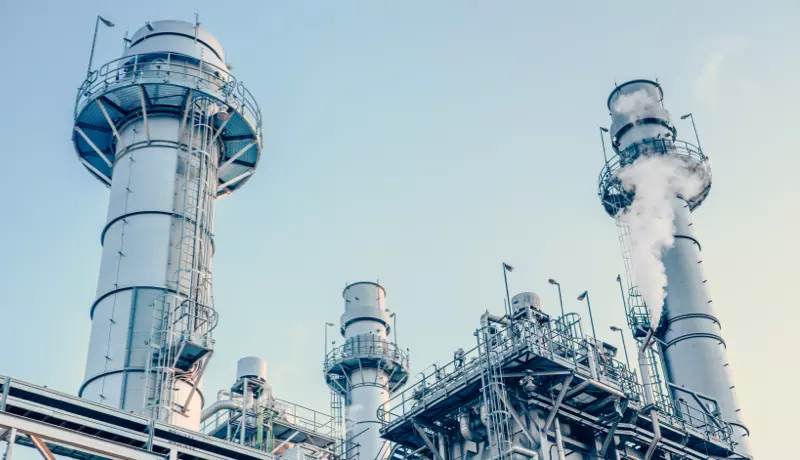Drying of Reforming & Hydrocracking Gas
Drying of Reforming & Hydrocracking Gas is sometimes referred to as steam methane reforming (SMR), this process involves the heating of methane (CH4) with steam, in the presence of a catalyst, to create hydrogen (H2) and carbon oxide byproducts. After the initial reforming reaction, the steam undergoes a water-gas shift reaction, which converts carbon monoxide (CO) into carbon dioxide (CO2) and more pure hydrogen. Finally, pressure swing adsorption is used to isolate the carbon oxides and leave a nearly pure stream of hydrogen. Since hydrogen does not naturally occur in an isolated form, steam reforming is a crucial process for creating hydrogen.
Aside from methane reforming, the most widely used process to generate hydrogen, other light hydrocarbons can be used in steam reforming processes including diesel, gasified coal, gasoline, natural gas, propane (C3H8), and renewable fuels such as ethanol and gasified biomass. Given its high purity after reformation, purified hydrogen can be used in petroleum refining for processing crude oil into refined fuels and removing contaminants such as sulfur. Hydrogen can also be used as an energy carrier and is commonly used for power cells.
Synthesis Gas (Syngas)
Steam methane reforming is a critical process for creating syngas, a valuable gas composed mostly of hydrogen and carbon monoxide (HyCO), which is used for creating ammonia, on-purpose hydrogen, and methanol.

Reformation Process
Steam methane reformation is an endothermic process that begins with a feed stream composed of desulfurized, light weight hydrocarbons. The hydrocarbon feed stream is mixed with superheated process steam (750-800˚C), which is then distributed in vertical reformer tubes that are filled with catalysts. These catalytic reformer tubes are heated from the outside, thus heating the hydrocarbon-steam mixture, and converting the stream to hydrogen and carbon monoxide, which is also known as synthesis gas.
Steam Methane Reforming reaction
CH4 + H2O + heat → CO + 3H2
CH4 + 2H2O + heat → CO2 + 4H2
Water Gas Shift
After the reformation process, the new gas stream undergoes a water gas shift (WGS) to react the carbon monoxide with steam, in the presence of a catalyst, which creates more hydrogen and converts the carbon monoxide into carbon dioxide. There are two stages in the WGS, the first is a high temperature shift, which is an endothermic reaction, occurring at 350˚C. The second stage is an exothermic low temperature shift, which occurs between 190-210˚C.
High Temperature Shift (HTS) reaction
CH4 + H2O + heat → CO + 3H2
Low Temperature Shift (LTS) reaction
CO + H2O → CO2 + H2 + heat
The high temperature in the HTS both reduces the residual content of methane and maximizes the yield of hydrogen, while preventing elemental carbon from forming and preventing fouling of the catalyst in the reformer tubes. To help increase the heat during this reaction, more steam is added to the hydrocarbon stream than is needed, thus superheating the stream.
Purification
Before being used in steam reforming, the feedstock stream undergoes purification processes to remove chloride (Cl), sulfur (S), and other impurities. After the stream has been reformed, the steam is put through a methanation step, which removes residual carbon oxides that were not removed in the water gas shift reactions. In place of the methanation step, some newer design SMR plants use a Pressure Swing Adsorption unit that utilizes molecular sieve to create a hydrogen stream with high purity.
Uses
Steam reformers can be used in an array of applications including petrochemical refining, ammonia synthesis, chemical production, electronics manufacturing, and more. In petrochemical refining, hydrogen is used to refine crude oil to create high value fuels, such as gasoline and diesel, and can be used to remove sulfur from these hydrocarbon streams. Some small-scale SMR units are used, but these units are typically large, centralized, industrial sized plants. High purity hydrogen is commonly used in fuel cells, which converts chemical energy into electrical energy. Being an energy carrier, hydrogen is combined with oxygen in the fuel cell, which produces heat, electricity, and a byproduct consisting of water vapor.
Products
HYG04DG 4A Molecular Sieve, Beads
HYG04DG molecular sieve is manufactured for the dehydration of hydrocarbon streams and can selectively remove water from both liquid phase and vapor phase streams. This dehydration process allows the hydrocarbon streams to be further processed in cryogenic separation and is more easily transported. This molecular sieve, with a high adsorption capacity, can bring benefits to a wide range of dehydration applications.
- used for the dehydration hydrocarbon streams
- capable of removing water to meet most specifications
- allows hydrocarbons to be further processed and transported
- offers an advantageous adsorption capacity
Isotherms
Email info@hengyeinc.com for more information.